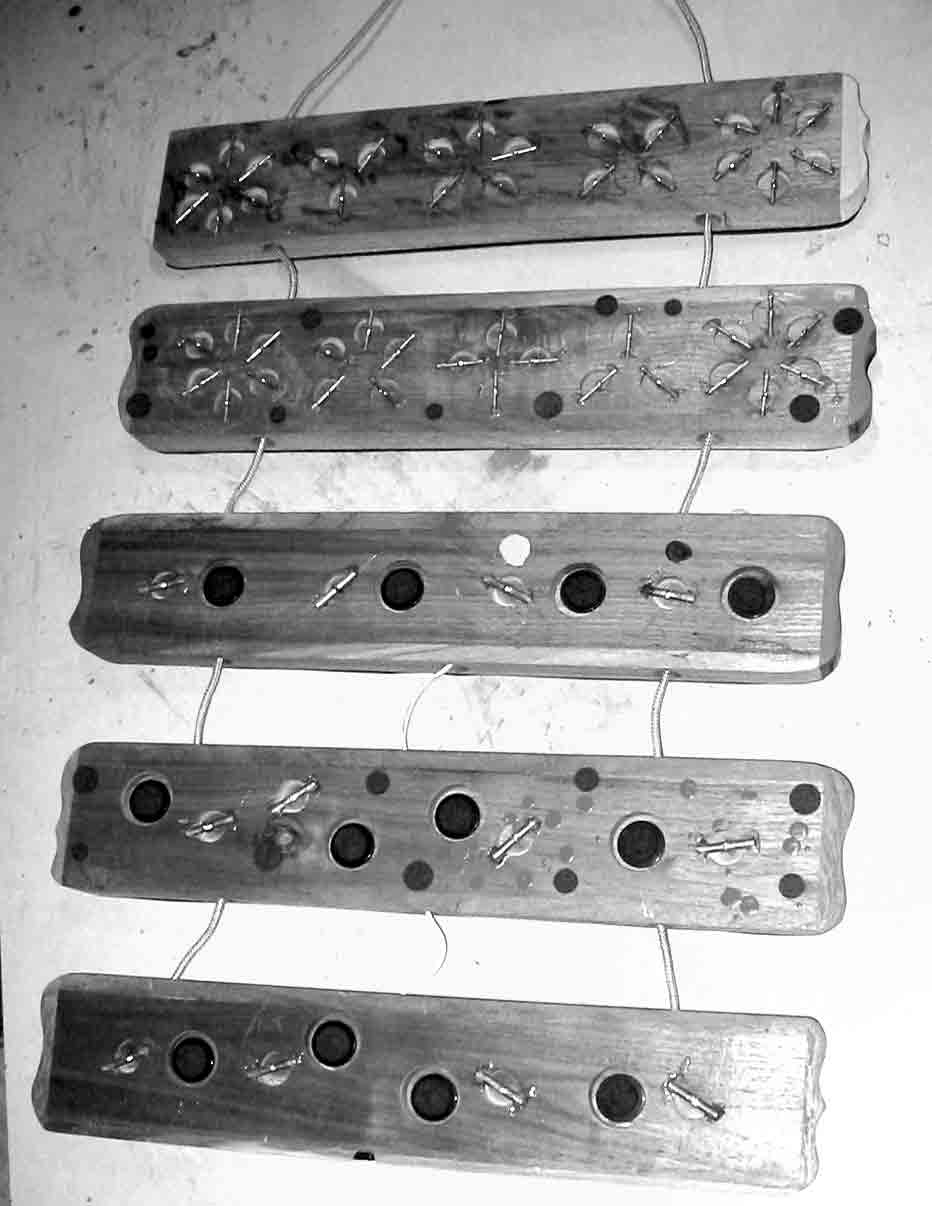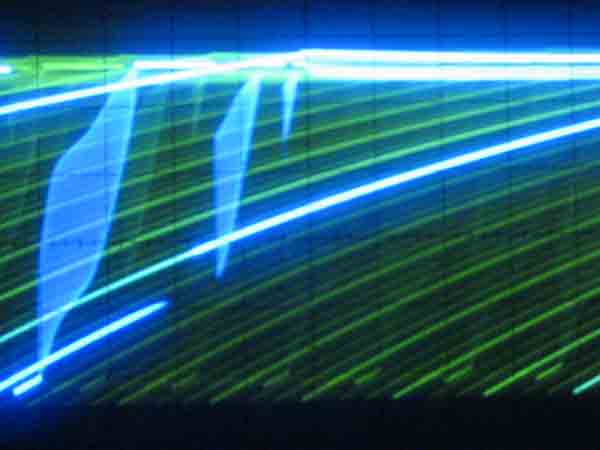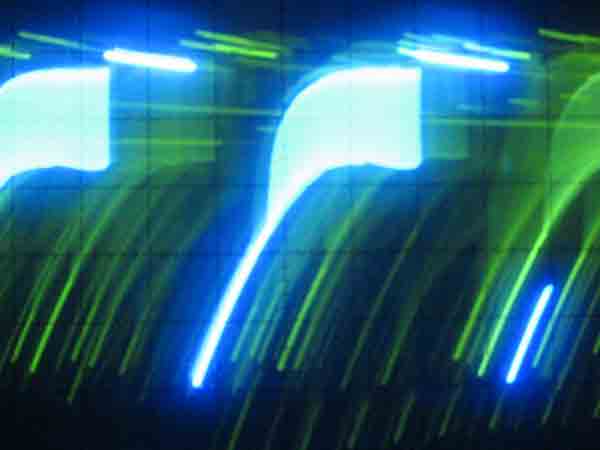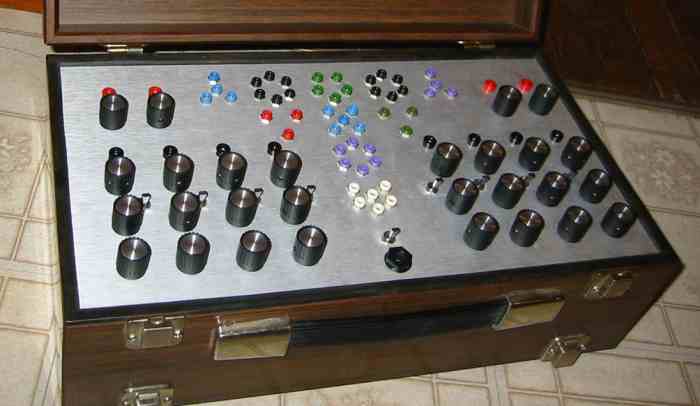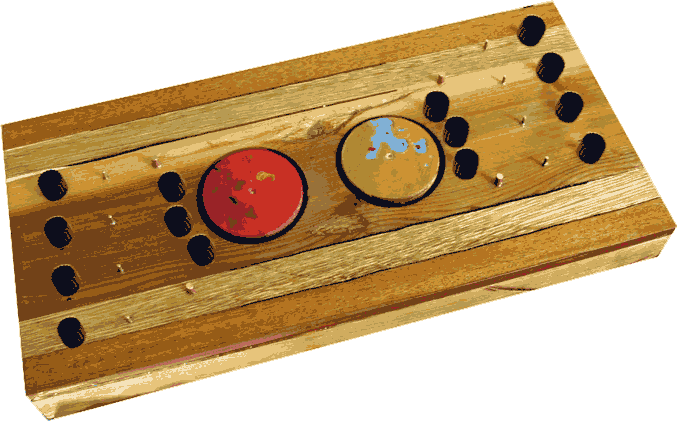|

Figure 1: A depiction of my first manifestation of the Rollz-5 circuits,
encased in five panels of Amish Walnut, tethered together with cloth-wire.
The paper circuits within number ten geometrical rolls and eight translators.
I built it in October 2006. 18” width, 24” height, 1” thick,
it hangs on a nail.

Figure 2: The actual paper circuit for a six-noded geometrical roll, this
describes the circuit as well as housing it.

Figure 3: An abstracted montage of geometrical rolls. Some connections
incorporate resistance, some do not.

Figure 4: An even roll, such as this six-noder, perpetuates a stable alternation
of verso and inverso.

Figure 5: This five-noded roll is odd, it encapsulates unresolved paradox.

Figure 6: A dual oscillograph showing raw, mostly odd-roll material (top)
and an Ultrasound Filter translation (bottom)

Figure 7: A dual view of a montage of raw even-roll pulses (top) and a
Gongs translation (bottom)

Figure 8: Even-roll pulse montage (top) and Auto-VDog translation (bottom).

Figure 9: An idea for a 3-dimensional paper circuit “ball” and
its accompanying translator glove.
|
Pretty Paper Rolls: Experiments in Woven Circuits
Peter Blasser
ABSTRACT
A history of my efforts to design sustainable and economical circuit construction
on paper, more akin to craft than industry. The focus is a collection
of modules called “Rollz-5”, which creates organic rhythms out
of geometrical forms. A future direction is to create electronic sound
devices based on the platonic solids and other 3-D topographies.
PAPER CIRCUITS
In 2006 I began making circuits on paper. Paper circuits are easier, cheaper,
and environmentally safer than the alternative- greenboards etched with
heavy chemicals at a factory. The idea, which I got from a St. Louis collective
known as “commonsound”, puts front (component) face and back
(trace) face adjacent and mirrored on the paper. The pattern is cut out,
folded in the middle, then pierced with a needle. The components are inserted
and their leads woven and soldered according to the trace pattern. I created
several pocket-size paper circuits that explore touchability and the complexity
of circular modulations. I play them by intuitively wiring or touching
nodes to each other to create different re-weavings of the internal circuits.
I consider these the most accessible of my designs; anyone can salvage
or buy the components after downloading the plans from my website (www.ciat-lonbarde.net).
Each build of a paper circuit is unique, because the time elements vary
by changing values in key locations. The transcription of electronic ideas
onto paper stimulates a free and open distribution of craft, where the
final pieces vary based on the skills of the maker. This appeals to an
ideal of medieval individuality, where information is distributed personally
through guilds as well as mnemonically in spellbooks and mandalas. The
paper circuit projects attempt to bring the art of electronics from an
impersonal, industrial approach to one which is individual and magical.
This crafty use of electronics encourages everyone who pursues it to personally
reduce waste; creativity leads to resourcefulness and vice versa.
ROLLZ-5
After creating several standalone pieces, I decided to design a group
of paper circuits that combine in diverse ways as an assemblage. I intended
to confront the notion of “drum machine”, which implies the
sterile regimentation of time, and transform it into a collection of organic
flows generated by geometrical forms. These forms and their accompanying
filters can be switched, wired, or touched; the final manifestations range
from a small preset switch-box, a squeezable spike-dome, or a traditional
modular. My first implementation uses five slim walnut panels, connected
by heavy cloth-wire, which I hang on the wall to play and fold up to store
(figure 1). I exposed the nodes on the surface as inlaid brass pegs, for
alligator clips to grasp.
The top two panels contain the pulse-brain circuitry- the geometrical
forms that I call rolls. They are three, four, five, and six-noded versions
of the same simple transistor circuit (figure 2). They cycle impulses,
inverting polarity at each node; imagine a pulse oscillator flipping at
a set frequency. From this humble base whole montages can be built by
connecting nodes to nodes on other rolls (figure 3). I abstract the rolls
as polygons; a square is a four-noded roll as a pentagon is five-noded.
Connections can contain a resistance which softly melds two nodes together;
a connection without resistance creates a new monad node. During experiments
with the rolls, I found an interesting difference between even and odd
ones. Take a 6-roll (figure 4). The lozenges surrounding it represent
the temporary state of each node, where white is inverse of black. Start
on a black node and follow the arrows- the impulse ends as it started.
The even rolls are stable and alone they maintain a certain periodicity.
Now look at the 5-roll (figure 5). Start on the star and follow the impulse
around- when you arrive on the start node now it is inverted. Odd rolls
exhibit a “paradox spiral”; in attempting to resolve their states,
they transcend periodicity and go into a sort of high-frequency chaotic
trance. The combination of even and odd lead to rich experiments in pulse
and periodic fuzz-burst.
Meditating on the oscillographs of my experiments, I realized I should
design filters, or translators, to bring the odd ultrasound/radio blurps
into audible range as well as work with the low frequency even pulses.
The bottom three panels of my Rollz-5 (figure 1) each contain four of
a kind of translator. For simplicity’s sake, I allowed one input
node and one control knob for each translator. By abstracting the most
important feature into one control, learning and controlling it is easy.
On the first translator, an “Ultrasound Filter”, the knob sets
the cutoff frequency around which ultrasounds are reflected down to audible
range. It uses a switched capacitor filter, which has a (happy) side-effect
of heterodyning high frequency sound by its reference tone. In figure
6, the top trace shows mostly odd-roll chaotic ultrasound, and the bottom
shows a translation. It sounds like an old-time radio as it sweeps through
stations; there are audible difference tones swooping up and down. This
translator also filters the timbre of the even pulses.
The second translator type is called “Gongs”. It works with
even pulse material, waiting a period set by the control knob, then pulsing
a resonant filter preset to a certain pitch and damping. Normally I would
desire moveable pitches, but I reconciled with set pitches because this
is a drum machine- The tones mark phrases around which melodies develop
externally, and I would rather control the phrase length than the tone
of the gong. Anyhow, a creative hacker could easily mod these circuits
to make the pitches moveable. Figure 7 shows an even pulse rhythm on top,
and a gong translation on the bottom. The sonic effect is anything from
a short woodblock tone to a long deep resonant gong, synchronized at short
or long periods.
The final translator type is called “Auto VDog”, which uses
the same resonant filter as Gongs, but at a very low frequency, to transform
pulses into a slow undulation. This undulation controls the amplitude
of a simple drone tone, to make a ghostly complement to the pulse material.
Figure 8 shows the raw pulses on top, and the translation on bottom. I
created this translator to balance with the plucked and pulsed sounds.
It’s like sending pulses through a watery wave-tank which speaks
a simple tone, a complement to the more abrupt rhythms of the other translators,
yet it relates periodically because it is based on the same raw material.
TOUR, FUTURES
On a recent tour of the US, the Rollz-5 served as the organic ostinato
on top of which we humans improvised gestural voice, trombone, flutes,
and strings. The Rollz-5 freed us to work on the more human elements of
the jam, while keeping a limp, or pleng, to the rhythm to keep it interesting.
Pleng is a Javanese Gamelan term describing tones an octave apart but
slightly detuned, to create shimmering difference tones. This term is
appropriate to any analog circuit really, because minute variations in
components that would ideally match create long difference tones. These
difference tones add variety to the phrasing in a truly organic way. In
Sarasota, after performing, I was approached by a student named Marcus
Aurelius to whom I gave a copy of the instructions to build the Rollz-5.
His enthusiasm jumped when he saw the geometrical forms and he told me,
“dude, this is sacred geometry!”. Seeing that I needed clarification,
he gave us a book by Drunvalo Melchizedek about the history of the “Flower
of Life” [1]. This hexagonal arrangement of circles or spheres leads
to a perfect diagram of all five of the platonic solids- tetrahedron,
octahedron, icosahedron, cube, and dodecahedron. I then realized that
the geometry of the Rollz-5 is two dimensional, and it could be further
elaborated into three dimensions. Figure 9 shows a future experiment involving
an electronic dodecahedron, a conductive glove, and a translator box.
How to translate is still vague, but one obvious idea is to heterodyne
the signal by that from another ball-glove, or forsake gloves entirely
and convert the balls into chaotic radio transmitters, received and heterodyned
by the translator. I would make the ball from paper circuit panels, soldered
together and tethered by a power cord, then covered with papier-mache
to protect unintended nodes from exposure. The concept could explore the
regular platonic solids, as well as multiplex forms such as buckminster
fullerines, and mutant topographies made out of irregular polygons. This
is not a drum machine but a 3-dimensional manipulation of chaotic fields.
Where will sound go after all the timbres and tones have been discovered?
This 3-dimensional manipulation is one possibility- it provides a complicated
topography translated from vortices and crystallizations into “normal”
timbres and back out again into ultrasound chaos.
BIOGRAPHY
Peter Blasser lives in Baltimore, MD, where he designs and builds electronic
sound devices for fun and profit. He also does landscaping, low brass,
and cooking. www.ciat-lonbarde.net
REFERENCE
1. Melchizedek, Drunvalo. The Ancient Secret of the Flower of Life, Volume
1 (Flagstaff, AZ: Light Technology Publishing, 1990)
|
